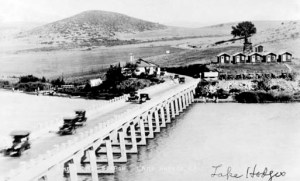“THOUSANDS CHEER WHILE BONDS BURN”
That was the headline in the San Diego Union of September 10, 1905. It was reporting on a gala event the day before in the city of Escondido. On that day, Admission Day statewide, some 3,000 people gathered to witness the burning of canceled bonds from the Escondido Irrigation District, freeing residents from a collective debt that had hung over the community.
It was a very big deal. The size of the crowd tells you something when you realize that the actual population of the city of Escondido was in the range of 800 to 1,000 at the time. It was a small, young city, incorporated less than two decades before. A $450,000 bond issue passed in 1890 built a dam and reservoir for a steadier water supply crucial for a budding agricultural economy. But economic hard times locally and nationally had undermined the community’s ability to pay the debt. Negotiations led to a compromise balance which was finally paid off in 1905. That made the burning of the cancelled bonds a cause for public rejoicing.
It was a party to which all southern California was invited. The Santa Fe railroad ran special trains from Los Angeles and San Diego. City bands from Escondido and San Diego were among the groups and individuals who provided musical entertainment. Mayor Sig Steiner joined other city officials in conducting the bond burning on the steps of the Lime Street School.
Here’s a photo of the event, courtesy of the Francis Beven Ryan historical collection in the Pioneer Room of the Escondido Public Library:
Over the next couple of years, residents began gathering at the site every September 9 to picnic and commemorate what many called “Freedom Day.”
At the same time, one of the crops which began to flourish on Escondido’s irrigated soil was the muscat grape. A horticultural report on the sweetness of the local grapes inspired Sig Steiner, who’d stepped down as mayor in 1906 but remained an important business and civic leader. He proposed that every September, on or about the 9th, there should be a community celebration called “Grape Day.”
“The idea is capable of extended development,” Steiner told the San Diego Union in August, 1908, “and I have no doubt that ‘Grape Day,’ when once celebrated, will become an established annual event in the valley.”
The rest, as they say is history. And history repeats itself next Sunday, September 6, when Escondido once again celebrates its special day in Grape Day Park, which includes the site where the liberatory bond-burning was held. For details see “History Happenings” below.
Sources for this post included historic San Diego and Escondido newspapers, the Journal of San Diego History, and the website of the Escondido History Center.
Get Updates Automatically-Become A Follower of the San Diego History Seeker
You can get weekly updates of San Diego History Seeker automatically in your email by clicking on the “Follow” button in the lower right corner of the blog page. You’ll then get an email asking you to confirm. Once you confirm you’ll be an active follower.
History Happenings-Upcoming Events in the Local History Community
Grape Day, Escondido’s most historic event, takes place September 6. A 5K fun run starts at 7:30, followed by a parade down Grand Avenue, culminating in the festival in Grape Day Park from 9:30 to 4. Free event includes grape stomping, an entertainment stage, vendor booths, fun zone, free grapes courtesy of Jimbo’s Naturally, a wine and craft beer tasting pavilion and lots more. For more info visit http://www.escondidohistory.org/index.html .
Open house at the Vista Historical Museum, 1-3 on Sept 13. Learn about the history of the museum, the former Rancho Minerva, and a little Greek culture. Hosted by three Girl Scouts earning their Silver Award. This is a community event and anyone can join. $7 donation includes tour, snack, presentation and patch. For further info call 760-630-0444.






